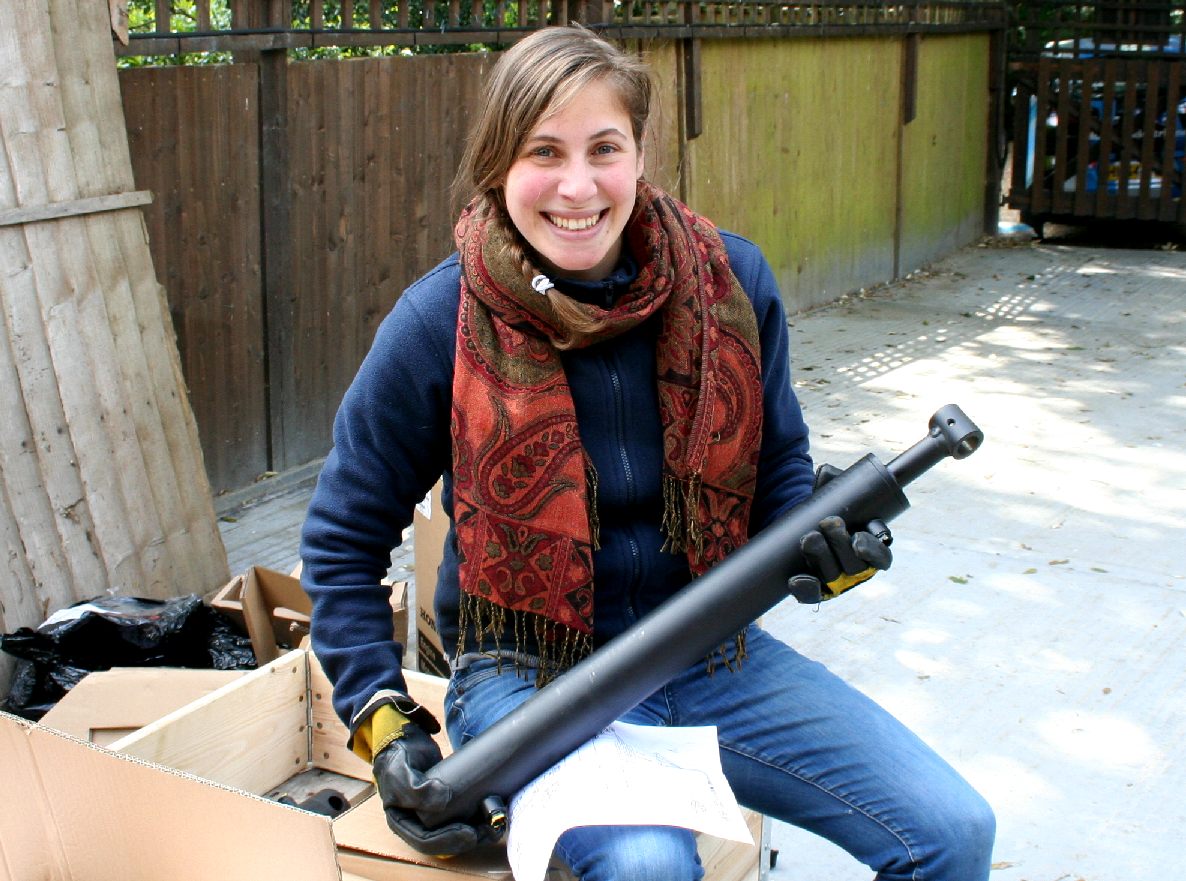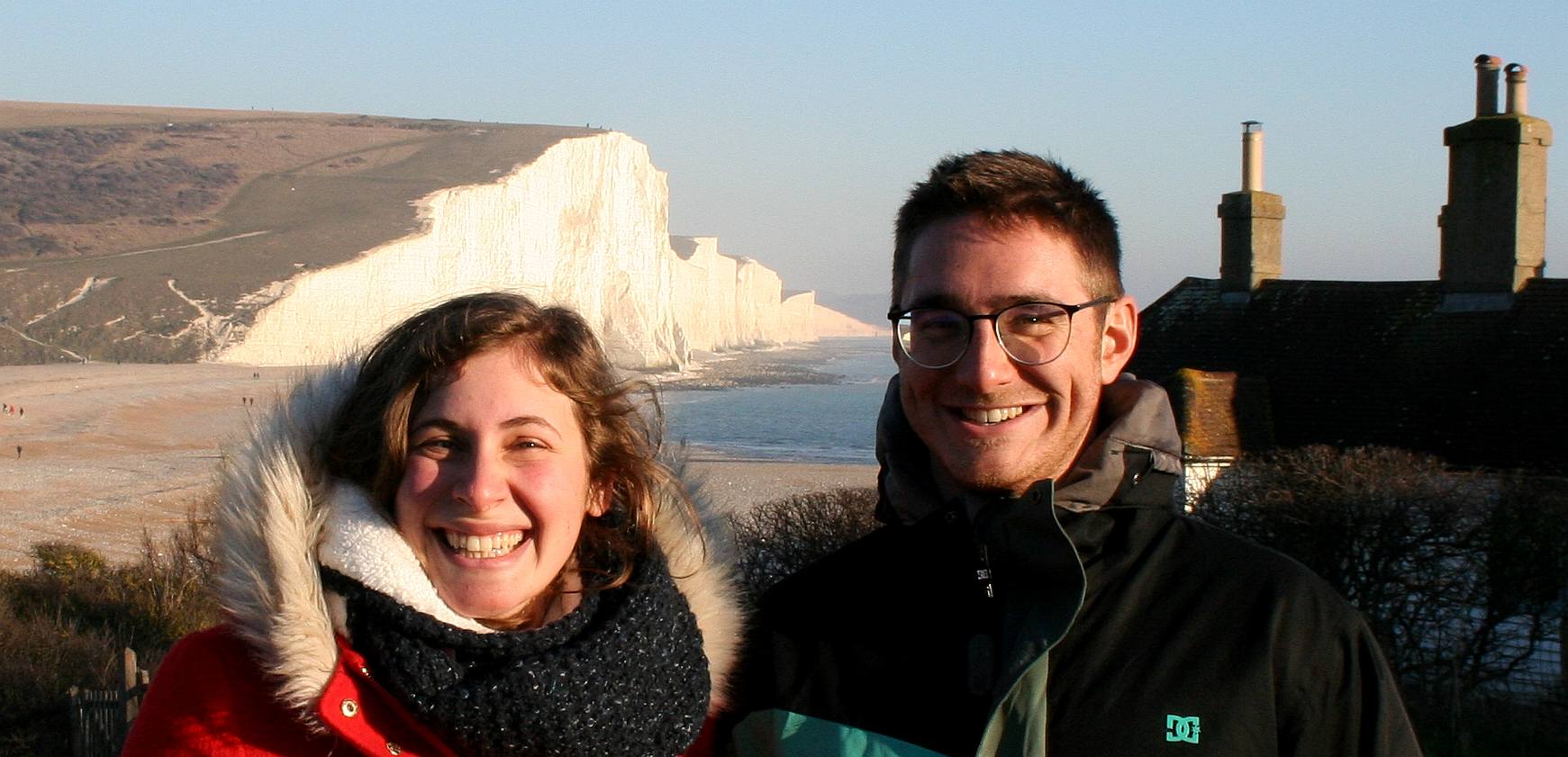|
LOLITA D'ORTONA
|
|
HYDRAULICS - The hydraulics arrived today. Lolita is holding one of the power rams that is to lift the mast of a prototype wind turbine rig. The cylinders work in pairs to raise and lower the wind turbines, all controlled by a Raspberry Pi micro computer. Copyright © photograph, 30 April 2019. All rights reserved, Cleaner Ocean Foundation Ltd.
ABOUT LOLITA
Lolita D'Ortona is a bio-engineering student in the final year of her Masters Degree at Liège University in Belgium. Her mission in England is to work with the SeaVax team to help design the lifting frame and wind turbine mounting head, to include the control robotics and hydraulic mechanicals.
The team would be starting from scratch with limited resources, aiming to have something operational on the wind turbine control aspect before July of 2019. You might think that the mechanical engineering of the structure and conversion of a Ford Transit van would take most of the time, but in fact it is the computer coding that is more likely to consume Lolita's efforts, while Chris Close, Nelson Kay and other team members take on the grunt of the welding and mechanics.
The SeaVax team recognise that this is a huge undertaking for an engineering student, but by applying her expertise as part of a team effort, and with equal enthusiasm from all the project members, Lolita hopes to help the Foundation eventually move the project on from the conceptual and development stages to the open sea as a 1/4 scale prototype of a SeaVax based vessel that the team are looking to build in 2020. See the diagrams below.
ECO ENGINEERS - Engineering is an art that can help us to change the world for the better. Lolita and Benoît visited the Cleaner Ocean Foundation workshops in 2019. They are seen here at Seaford Head in Sussex, one of the most famous beauty spots in England. The chalk cliffs in the background are the Seven Sisters. Copyright © photographs, February and March 2019. All rights reserved, Cleaner Ocean Foundation Ltd.
CAD - Hard at work designing the framework that will lift two 400w wind turbines roughly 3 meters higher into the air to search for more energy. Lolita uses computer aided design software to build the structure in 3D for movement and stressing. Copyright © photographs, February and March 2019. All rights reserved, Cleaner Ocean Foundation Ltd.
CUTTING EDGE - [LEFT] Jumping straight into practical engineering, Lolita is seen here cutting some of the steel tubing that was used to construct the Transit test rig. Copyright © photograph, 11 April 2019. All rights reserved, Cleaner Ocean Foundation Ltd. DELEGATE - [RIGHT] As part of the SeaVax development team for 2019, Lolita attended the morning and afternoon sessions at the NOC in Southampton on the 8th of April 2019, taking part in the discussions about SME funding and Atlantic blue growth projects and networking with other delegates on behalf of the Foundation. Copyright photograph © 8-04-19 Cleaner Ocean Foundation Ltd, all rights reserved.
Lolita became involved in the SeaVax project in the spring of 2019. She will be working with mechanical engineers and fabrication technologists to construct a prototype in one quarter scale using steel and MIG welding equipment until May 2019, after which as part of a very tight schedule she returns to Belgium to complete her studies and take her exams.
The Foundation operates from modest facilities in Sussex, England using mainly the skills and ingenuity of their volunteers to take ideas from the drawing board out into the real world. They even work outside in all weathers.
The quarter scale coastal rig represents a major development stage of SeaVax regeneration aspirations, in the quest to not only clean plastic from our oceans using only energy from nature, but also to develop recycling of otherwise wasted resources - by way of a truly circular economy. Coastal work includes river cleaning and sampling. Conservation is the name of the game.
MAST ALIGNMENT - Working on one of the steel frames that forms the mast. Lolita helped the Foundation's boat builder to mark out the positions of the brackets that take the pins for the ends of the hydraulic rams. There are two matching frames like this. Copyright © photograph May 16 2019. All rights reserved, Cleaner Ocean Foundation Ltd.
LOLITA'S RESEARCH >>>>
BACKGROUND
The current state of energy capture at sea using wind turbines relies on vertical darius or axial flow generators that are mounted rigidly on deck at a relatively low level in relation to sea level and traditional sails. Some axial flow turbines can be turned to capture the wind as a vessel changes headings.
THE PROBLEM
At a low level on deck the positioning of wind turbines presents a potential danger to any crew, who might accidentally venture too close to the revolving blades. In addition, deck mounting reduces the energy that can usefully be captured unless the turbines can escape the ocean boundary layer and as many deck obstructions as possible, where such obstructions are sure to interfere with energy capture.
THE SOLUTION
ABOUT
SEAVAX
The SeaVax project encompasses many of the Sustainable Development Goals that the UN are hoping to achieve in one. Where Seavax is solar and wind powered, meeting SDG 7 aims and in the longer term SDG13, as in research into zero emission ocean transport to combat climate change and global warming. The objective is to develop the innovative technology (SDG9) to help in the fight alleviate hunger and provide food security (SDG2) and the vessels clean rivers and oceans (SDG6). Lastly, WOAA sits well with SDG17 in that the proposed World Ocean AntiPlastic Alliance encourages international cooperation in seeking to clean the oceans as per SDG14.
FORD TRANSIT - This is the Ford Transit that was spruced up with artwork by Emily Hoad, a marine biologist who worked with us in 2018. The van will double up to carry comestibles for the crew during ocean awareness events and during on site construction of SeaVax vehicles, with just a little more artwork to complete the underwater scene. Copyright © photographs, 17 August 2018. All rights reserved, Cleaner Ocean Foundation Ltd.
MAST HEIGHT - In these diagrams you can see the boom raised a little over three meters where the twin turbines should be operating in cleaner air. On the ocean the height difference should see a significant improvement in performance, especially when combined with solar panels where shading is a big issue. The wind turbines operate in conjunction with solar panels arrays as two wings and a central deck area. The solar wings can track the sun and fold over each other for safe storage when weather conditions are unfavourable. At such times the wind will be blowing harder, leaving the turbines to take advantage of the energy source until it become dangerous. This is where the folding mechanism comes into its own.
INTERNAL MODIFICATIONS - The start of the internal frames that will carry twin hydraulic double acting cylinders to power the mast up and down. In this picture we see a timber floor pad and uprights before the steel bracing is added. Copyright © photograph 16 May 2019 Cleaner Ocean Foundation Ltd. All rights reserved, save for educational and research purposes.
TEST FIT 1 - The lower mast arm was test fitted with roof cushions in place and using an engine hoist as a safety. The fit was near perfect. The arm was removed for welding to be completed and for painting. Copyright photograph © 12-05-19 Cleaner Ocean Foundation Ltd, all rights reserved.
TEST FIT 2 - The upper mast arm was test fitted using the same method. Again the fit was near perfect. We breathed a sigh of relief. The other (working) end at the top of the mast still in the workshop also has to fit to the same standard. The Ford Transit van looks as though it is wearing sunglasses. Copyright photograph © 12-05-19 Cleaner Ocean Foundation Ltd, all rights reserved.
All of us at the Cleaner Ocean Foundation thank Lolita for her sterling efforts on this project that began on Monday the 25th of March, and for putting up with the English weather. We wish her great success as a bio-engineer and other eco adventures.
WINDY COASTLINE - One thing Lolita noticed was the difference between wind speeds inland and on the coast. She visited Newhaven Harbour and Brighton seafront, including the famous Palace Pier, to see for herself just how blustery it can be along the shores of England. Copyright © photographs, 9 March 2019. All rights reserved, Cleaner Ocean Foundation Ltd.
COASTAL DESIGN (DRAFT) - This design is based on the wind turbine test rig we are aiming to complete in 2019 with Lolita's help. The solar panel layout is identical and so is the wind turbine arrangement. The only difference is that we'll be doubling up on the energy harvesting front with 4 wind turbines and 24 solar panels to give us 5,200 watts incoming energy for each hour of peak generation. This may not be much by SeaVax standards, but it is all we think we might be able to afford where funding for this kind of research is normally aimed at universities and big businesses.
A small not for profit concern like the Foundation is left out in the cold somewhat, because we do not have a profit motive. Nor do we have existing products on sale to support such R&D. Corporations and academia have bigger budgets to be able to make complex applications for Horizon 2020 funding, build necessary consortiums and the like - all of which would sap our time and money, for an also-ran "thank you for applying," but you have been unsuccessful on this occasion. What the policy makers do not seem to realise, is that if funding is not achieved, there might not be a next time - as in the case of so many other missed opportunities where policy makers have slipped up. The oceans will get more clogged up with plastic and fish stocks could fail. The supposed savior; Aquaculture, is largely based on fish feed and many species, such as salmon, are farmed in the ocean where toxins are rife from biomagnification effect.
This rig will feed eight 110 AH deep cycle (lead-acid) leisure batteries to begin with, but we may change to lithium technology as and when funding allows, since this rig may be the subject of further testing and development for the full size SeaVax prototype. The point here being to provide the basic vessel onto which seawater sampling and cleaning experiments might proceed. To date this design has been funded entirely by our trustees and volunteers. Copyright © diagrams March 2019. All rights reserved, Cleaner Ocean Foundation Ltd.
BEACH LAUNCHED FISHING FLEET - Hastings in Sussex is home to the world's largest fleet of beach launched fishing boats. The second largest beach launched fleet is at Ngawi Beach in New Zealand. The launch method is near identical where bulldozers push the boats into the water. At Hastings cable winches pull the boats back out of the water. At Ngawi special boat trailers are used to make recovery easier. Lolita saw this fleet of fishing boats for herself. Important where SeaVax and RiverVax vessels are designed to be beach launched.
The beach at Hastings is strewn with single use plastic, fishing nets and ropes. The youngest member of the SeaVax team seen on the right, Ryan, picked up several disposable lighters and other plastic waste from the beach on this visit to the coastal town, that is perhaps more famous for the Battle of Hastings in 1066. Copyright © photographs, 16 March 2019. All rights reserved, Cleaner Ocean Foundation Ltd.
LINKS & REFERENCE
Université de Liège
https://uk.linkedin.com/ https://www.facebook.com/
Copyright © March - May 2019 Cleaner Oceans Foundation.
|














